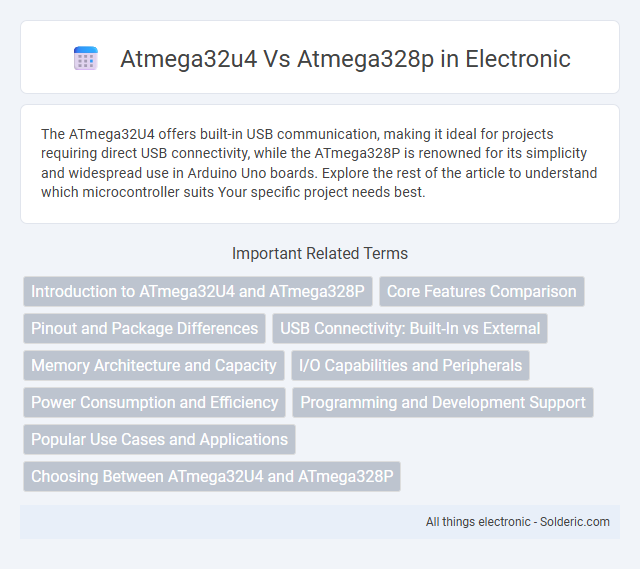The ATmega32U4 offers built-in USB communication, making it ideal for projects requiring direct USB connectivity, while the ATmega328P is renowned for its simplicity and widespread use in Arduino Uno boards. Explore the rest of the article to understand which microcontroller suits Your specific project needs best.
Comparison Table
| Feature | ATmega32U4 | ATmega328P |
|---|---|---|
| Core | 8-bit AVR | 8-bit AVR |
| Operating Voltage | 2.7 - 5.5V | 1.8 - 5.5V |
| Flash Memory | 32 KB | 32 KB |
| SRAM | 2.5 KB | 2 KB |
| EEPROM | 1 KB | 1 KB |
| CPU Speed | 16 MHz | 20 MHz (max) |
| USB Interface | Full Speed USB 2.0 (device) | None |
| ADC Channels | 12 (10-bit ADC) | 6 (10-bit ADC) |
| Timers | 4 (8/16-bit) | 3 (8/16-bit) |
| USART | 1 | 1 |
| SPI | 1 | 1 |
| I2C (TWI) | 1 | 1 |
| PWM Channels | 7 | 6 |
| Package Types | TQFP, QFN | PDIP, TQFP, QFN |
| Key Feature | Built-in USB controller for direct PC connection | Standard AVR microcontroller without USB |
Introduction to ATmega32U4 and ATmega328P
The ATmega32U4 and ATmega328P are both popular microcontrollers from Microchip Technology, each featuring AVR architecture but designed for different applications. The ATmega32U4 integrates native USB functionality, making it ideal for USB-based projects, while the ATmega328P is known for its simplicity and widespread use in platforms like Arduino Uno. Your choice depends on whether USB communication or general-purpose performance is a priority in your project.
Core Features Comparison
The Atmega32u4 offers built-in USB communication with native USB support, making it ideal for projects requiring direct USB interaction, while the Atmega328p lacks native USB and relies on external components for USB functionality. Both microcontrollers feature an 8-bit AVR core, 32 KB flash memory, and similar clock speeds up to 16 MHz. Your choice depends on whether integrated USB communication is a core requirement for your application.
Pinout and Package Differences
The ATmega32U4 features a 32-pin TQFP or QFN package offering built-in USB functionality with pins dedicated to USB D- and D+ lines, whereas the ATmega328P commonly comes in a 28-pin DIP or TQFP package lacking native USB support. The ATmega32U4's pinout includes extra GPIO pins and specialized USB interface pins, allowing direct USB connectivity, which the ATmega328P requires external hardware to achieve. Package size differences influence board design flexibility, with the ATmega32U4 being favored for compact USB-enabled applications due to its integrated USB interface and more pin options.
USB Connectivity: Built-In vs External
The ATmega32U4 features built-in USB connectivity, allowing direct USB communication without additional components, making it ideal for USB HID projects like keyboards and mice. In contrast, the ATmega328P requires an external USB-to-serial converter, increasing design complexity and cost for USB-enabled applications. Your choice between these microcontrollers depends on the importance of integrated USB support for streamlined development and compact designs.
Memory Architecture and Capacity
The ATmega32U4 features 32 KB of flash memory, 2.5 KB of SRAM, and 1 KB of EEPROM, supporting native USB communication which enhances its versatility in USB device projects. In contrast, the ATmega328P offers 32 KB of flash memory, 2 KB of SRAM, and 1 KB of EEPROM, making it suitable for applications with standard serial communication requirements. Both microcontrollers use a Harvard architecture but differ in SRAM capacity and USB support, affecting their suitability for memory-intensive tasks and USB-enabled designs.
I/O Capabilities and Peripherals
The Atmega32u4 features 26 programmable I/O pins and an integrated USB interface, making it ideal for USB-enabled projects, while the Atmega328P offers 23 I/O pins without native USB support. Peripherals on the Atmega32u4 include a full-speed USB 2.0 device, USART, SPI, I2C, and multiple timers, whereas the Atmega328P provides USART, SPI, I2C, and timers but lacks the USB interface. The Atmega32u4's enhanced peripheral set enables more versatile connectivity and control options compared to the Atmega328P.
Power Consumption and Efficiency
The ATmega32U4 typically consumes more power than the ATmega328P due to its integrated USB functionality and additional peripherals, making the ATmega328P more efficient for low-power applications. ATmega328P operates effectively in sleep modes with lower current draw, ideal for battery-powered devices where power efficiency is critical. Your choice between these MCUs should consider the balance between USB connectivity needs and power consumption requirements to optimize overall system efficiency.
Programming and Development Support
The Atmega32u4 offers integrated USB support, enabling direct programming and USB communication without extra hardware, which simplifies development for USB-enabled projects. In contrast, the Atmega328p requires an external USB-to-serial converter for programming and communication, adding complexity to the development process. Both microcontrollers are supported by the Arduino IDE, but the Atmega32u4's native USB interface provides more versatility for advanced applications.
Popular Use Cases and Applications
The ATmega32U4 is popular in USB-enabled projects, such as custom keyboards, game controllers, and wearable devices due to its native USB support, allowing direct connection to computers without additional hardware. The ATmega328P dominates in basic microcontroller applications like Arduino UNO-based robotics, sensor networks, and simple automation projects because of its widespread ecosystem and ease of use. Choosing between the two depends on whether your project requires integrated USB communication or a straightforward, cost-effective microcontroller solution.
Choosing Between ATmega32U4 and ATmega328P
Choosing between the ATmega32U4 and ATmega328P depends on project requirements such as USB connectivity and peripheral features. The ATmega32U4 integrates native USB support, making it ideal for USB devices like keyboards and mice, while the ATmega328P lacks built-in USB and relies on external modules for USB communication. For low-power applications and straightforward microcontroller tasks, the ATmega328P offers simplicity and widespread support, whereas the ATmega32U4 provides greater flexibility with features like additional hardware UARTs and enhanced ADC capabilities.
atmega32u4 vs atmega328p Infographic

 solderic.com
solderic.com